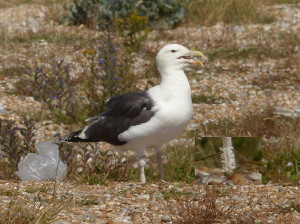
A lovely sunny day prompted me to head to Dungeness on the coast of Kent this morning in the hope of seeing some terns and gulls at the water outlet of the nuclear power plant – “the patch”. Unfortunately there were very few birds at all there, just 20-30 Herring Gulls of varying ages and a couple of Black-headed Gulls and no terns at all which is a little unusual for the time of year. I spent some time watching but very little of interest was to be seen so I headed back along the access road to see if I could find any roosting gulls, finding a couple of small groups to photograph from the car.
A group of gulls lurking around the back of a fish hut, fighting over scraps, caught my attention and a quick look at them revealed a single juvenile Yellow-legged Gull among a group of Great Black-backed and Herring Gulls. These bold birds allowed me to approach fairly closely and I made sure I got some nice photos of Great Black-backed Gulls in different ages but it was not until I got home that I noticed that one of the birds I photographed was wearing a colour ring with an alphanumeric code on it.
Zooming in on the ring I could see that the code started with an “A” and seemed to be followed with a “7″. The following character looked like a “5″ or “S” but I could not read the fourth character at all. A little research online took me to this website - http://www.cr-birding.org – which allows observers to search for ringing projects by entering the information available to them. I was able to narrow down my search by species and leg ring and the resultant listings showed just one project ringing Great Black-backed Gulls on the right leg, using a white ring and with a code beginning with “A”. I was able to obtain the email address of the project leader and sent him a message with all the details I could give him of the sighting and two photos showing the bird with the leg ring visible.
Anyone who sees/photographs a bird in Europe with a leg ring can enter details, even just partial details, and find the project that their bird comes from and contact the project leaders. This is a valuable source of information about birds which can contribute to their conservation and I know that ringers are always very keen to receive information about recoveries/sightings of the birds they have ringed. When I received a reply to my email I learned that this individual had been ringed at Rye Harbour, in nearby East Sussex and that almost all reports of it have been made in between the two sites; this bird is obviously not a fan of long distance flight!
On Dungeness RSPB reserve I spent some time in the hide overlooking the ARC pits where there were 1 Little Stint, 1 Wood Sandpiper, 1 Ruff, 5 Little Ringed Plovers and 2 Garganey. Although these species are not common sightings in UK the most interesting bird of the day to me was the adult Great Black-backed Gull with its colour ring.


 August 2nd, 2015
August 2nd, 2015  Nick
Nick  Posted in
Posted in  Tags:
Tags: 










